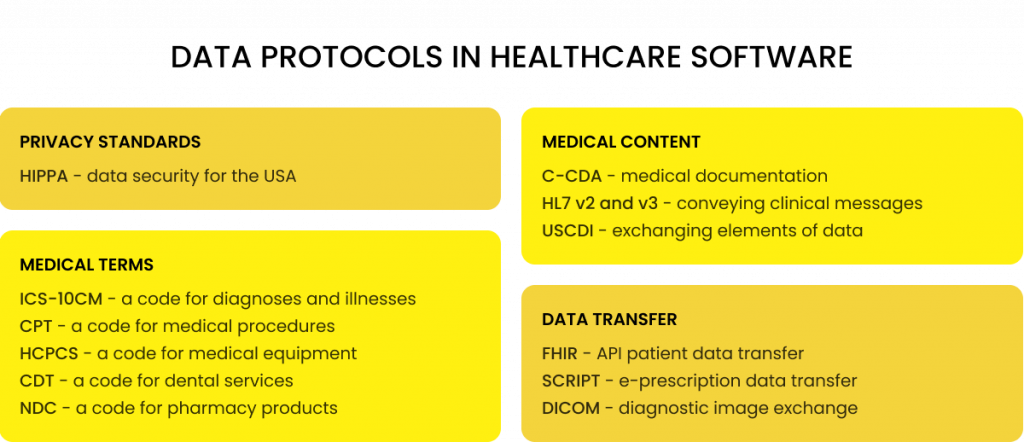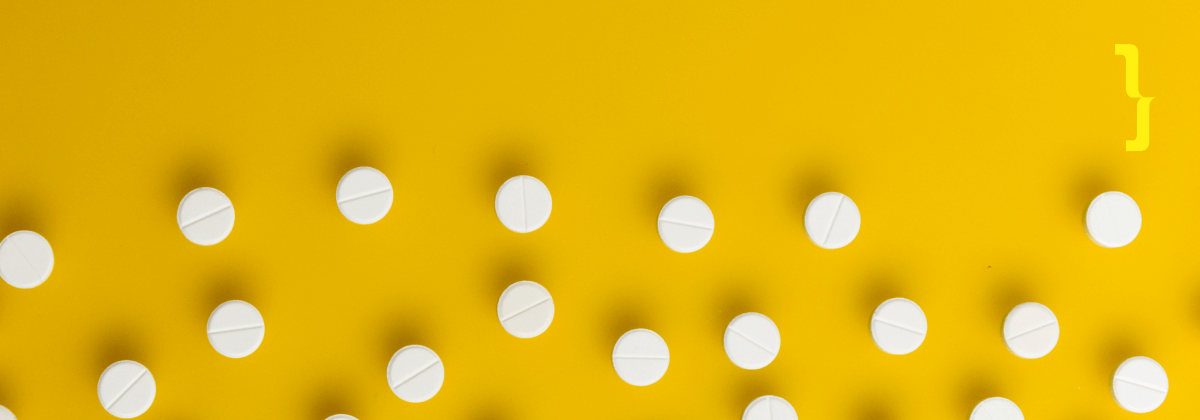Nowadays, IT healthcare solutions are vital for medical organizations to function properly. MedTech software, such as medical ERPs, EHRs, and medical applications bring the digital revolution to healthcare and help medical organizations develop faster. Nevertheless, IT protocols remain in the grey area of healthcare software development as yet.
In the era of digitalization in the healthcare industry, it is extremely important to raise awareness of IT standards that help to handle security issues. Using software in the medical business means handling important patients’ data. A survey conducted in the U.S. shows what steps healthcare institutions usually take to comply with data privacy regulations. As you can see, data management principles in medical software development are something that just cannot be skipped.
Table of Contents
Things You Will Learn
In our blog post, you will learn the key laws and regulations that are necessary for developing medical software. Whether you are looking for developing healthcare solutions or you are a medical software provider – getting familiarized with IT standards for healthcare will help you understand the functioning of MedTech software better. After reading our article, you will get to know:
- Common IT regulations in healthcare,
- How implementing IT standards can improve the functioning of medical organizations,
- Features that are must-have for every medical software,
- How to take care of data security in MedTech software.
What are the common IT standards in healthcare?
When developing healthcare solutions, it’s important to keep the basic IT standards in mind, such as:
Privacy & Security Standards
Privacy and security standards in developing medical software help to set up stable administrative and technical policies. It helps to protect confidential patient information and sensitive health data from unauthorized access or exposure.
HIPAA for ensuring data security
In the US, Health Insurance Portability and Accountability Act (HIPAA) formalizes all privacy standards for storing medical information. For example, it outlines the use of codes in medical billing (such as ICD-10-CM, CPT, HCPCS, CDT, and NDC).
What is HIPAA?
Some eHealth and mHealth apps are subject to HIPAA (Health Insurance Portability and Accountability Act) medical software regulations for the U.S. It’s the equivalent of GDPR (General Data Protection Regulation) in Europe. HIPAA Privacy Rule establishes national standards for the protection of certain health information.
Content Standards
There are certain rules that govern the structure of the content in electronic medical documents. They help organize the healthcare data properly and stick to a clear and easy-to-understand format.
C-CDA for organizing medical documents
C-CDA (Consolidated Clinical Document Architecture) is a basic framework for creating and managing electronic documents in healthcare. It helps to arrange medical records and capture crucial patients data. C-CDA comes in handy while managing clinical documents, especially in the following scenarios, as:
- the Consultation Note template that helps medical practitioners request the opinions of their supervisors;
- the Continuity of Care Document (CCD), which includes medical content concerning a patient, such as family history, information about diseases or allergies, etc. CCD documents allow for data transfer. It comes in handy while transferring patients between medical institutions;
- the Diagnostic Report as a way to interpret data from the diagnostic images and then share it easily.
Transport Standards
Transport standards simplify the exchange of data between different health systems. They suggest key areas that help to accomplish medical data and document exchange, such as appropriate formats, architecture, data, coding methods, or APIs.
FHIR for access to medical records
FHIR (Fast Healthcare Interoperability Resources) is a regulation that governs sending clinical information electronically. It is a set of HTTP-based RESTful APIs that facilitate data sharing and communication between different medical software. Besides its benefits for medical staff who are in charge of healthcare platforms, FHIR is also extremely useful for patients. FHIR also supports developing medical applications, so that everyone who has got an app can get private access to important medical records.
Main IT standards for creating healthcare software include the areas such as:
- medical terminology,
- content and structure of medical documents,
- data exchange,
- transport,
- privacy and security.

Take a closer look at how we brought the digital healthcare revolution to 9am.health project >>
Key Features of Medical Software Following Top IT Standards
Following the basic IT regulations is the core part of developing MedTech solutions. Here are the most important features of medical software that will help every modern healthcare institution in handling digital data.
Content Storage
When developing a medical platform or application you need to take into account the regulations on managing medical content. Having all medical procedures in one place will provide transparency of information for any medical facility. Healthcare software based on cloud solutions will provide your business with proper data management and security. Due to updates, it will be much easier to introduce some changes to the medical documentation.
Workflow Automation
Regardless of the size of the healthcare institution, cooperation between departments is crucial to creating unified policies. Whether you are responsible for a whole complex healthcare system or only for a single department within a medical organization, you need proper data transfer between different software and tools. Software with automated workflows will help you to manage all medical processes efficiently. Medical applications, as well as healthcare platforms, should allow streamlining and updating medical policies.
Collecting Signatures
Good healthcare software solutions should have the feature of capturing digital signatures in clinical records. The ability to collect electronic signatures legally on important patients’ documents is an essential feature of every type of medical software. This gives your medical organization credibility. It’s also the way to keep up with medical law standards and protect your healthcare business from penalties.
Version Control
It is a critical element of good MedTech software, as it creates a shared environment for all policies within one medical organization. Having control over different versions of medical software allows you to track all the history. For instance, it gives you insight into every policy’s update or revision. In this way, you can see who from the medical staff (and when) made even a minor change to the system. Plus, it prevents medical workers from having access to outdated information concerning their patients.

Discover TOP 10 healthcare trends we have recently written about:
TOP 10 Healthcare Technology Trends in 2022
Take Care of IT regulations for your MedTech Software
Are you a C-suite executive, who considers an ERP system for a healthcare organization? Or maybe you need a medical application for your business? If you want to have fully-fledged medical software solutions, you need to make sure it’s developed according to proper IT regulations. Introducing IT standards in the areas we mentioned above will help you create better medical software.
And if you need to develop some brilliant healthcare solutions, contact our teams of IT specialists – we’ll be more than happy to help you!
